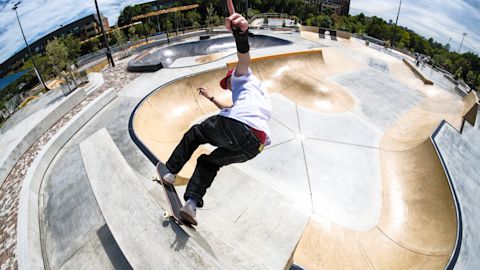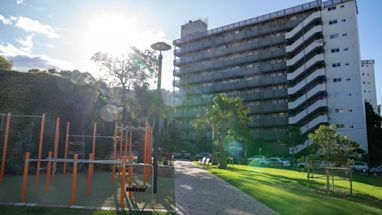1. The skate park
Open in late December 2020, the skate park features the largest public flow bowl in Sydney, a beginner’s bowl and an expansive skate plaza riddled with challenges. The separate areas cater for people of all abilities on skateboards, BMX bikes and scooters.
Distinct areas and features include:
- An extensive plaza with obstacles for street-style technical tricks, including banks, rails, ledges, stairs, vertical wall and quarter pipe
- An international competition-standard large flow bowl with depths of up to 3.3 metres for advanced skaters and riders.
Viewing areas, seats and trees are scatted throughout the skate park. New picnic areas and barbecues have been installed and a final piece of a path now connects the entire park.
In a nod to the park’s transformation from a brickmaking site to rubbish dump, recycled bricks have been used to pave walking paths within the facility.
2. The chimney stacks
The chimney stacks are Sydney Park’s calling card. Ever wondered what their story is?
In 1893, the Bedford Brick Works was established here to take advantage of the area’s clay beds. Clay was extracted from deep pits in the ground and fired into bricks in large kilns. This business survived until 1970, when others didn’t, because it invested in steam-powered machinery and modern kilns.
From around 1950, parts of today’s Sydney Park were also used as a rubbish tip. Household waste was dumped in the former brickpits until 1976. Today, the stacks form a central part of the landscape and remind us Sydney’s industrial history.

3. Stormwater harvesting
The City’s largest water harvesting system captures 850 million litres of stormwater a year. The system filters and diverts water to irrigate the wetlands in the park, which would otherwise drain away.
Before the water reuse project started, these wetlands didn't have a sustainable water supply. Now, this award-winning system cleans stormwater, manages floods and helps reduce urban heat.

4. Water Falls, wetlands and wildlife
Water Falls, by award-winning kinetic artists Jennifer Turpin and Michaelie Crawford, is an extension of the stormwater harvesting system. It releases the captured water through terracotta troughs, elegantly releasing it into a pond. The work’s support structures have become part of the wetland habitat, creating perches for local birds.
The wetlands are an important habitat for native wildlife during dry periods due to the park’s permanent water supply. The black-winged stilt and the black-fronted dotterel are local residents. Black swans and the Japanese migratory bird, Latham’s snipe, also visit the park. The wetlands are attracting a growing number of frogs and eastern long-necked turtles.

5. A playground for dogs and humans
The large children’s playground will have kids mesmerised and adults wishing they could join the fun. The tactile play area has many different types of equipment. The Sydney Park Cycling Centre provides a space for families to learn about cycling and road safety. And the park has off-leash areas, so your dog can roam free in the wide open spaces.
6. Sydney City Farm
The park also hosts Sydney City Farm, our urban agriculture project. It’s a place to learn about producing organic, sustainable and affordable crops. This is also where we grow seasonal produce. Volunteer opportunities are available for locals to get involved.

Sydney Park is located on Sydney Park Road in Alexandria.
Published 13 July 2018, updated 17 October 2023



